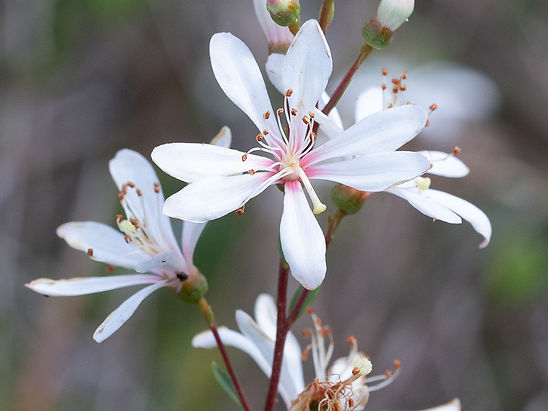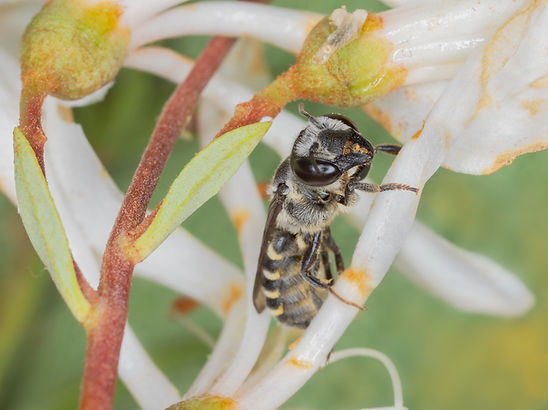SHARP-EATMAN
NATURE
PHOTOGRAPHY
FLORIDA BEES
IDENTIFICATION PAGE # F 11A
June 2024
Megachile georgica
M. xylocopoides & M. lanata
from Gainesville
The Georgian resin bee has the narrow, parallel-sided body typical of resin bees of the subgenus Chelostomoides. Both male and female Megachile (Chelostomoides) georgica are slender, black bees with abdomens encircled by pale hairs. Female Megachile georgica have pale scopal hairs under the abdomen. (The scopae of the female bee shown here look bright golden-orange because they are covered with tarflower pollen.) Both males and females are about 2/3 the size of a typical honey bee.
The male and female bees shown here were foraging on tarflower (Bejaria racemosa), a plant with fragrant, large white flowers. Also called flycatcher, tarflower has sticky petals and buds that trap flies and other insects (although it doesn’t digest them like truly “carnivorous” or insectivorous plants).
The female bee shown here was one of many gathering pollen from tarflower plants in a sandhill habitat in mid-June 2024. Two weeks earlier, male Georgian resin bees had appeared on the same plants. The male bee shown here was found stuck on one of the tarflower buds. It spent considerable time tugging itself free from the tarflower. Afterwards, however, it returned to the same tarflower plant and gathered on it with the other males.
Other bees of the genus Megachile are known to visit tarflower (M. brevis pseudobrevis, M. mendica and M. petulans). There are also records of honey bees, some sweat bees, and bumble bees visiting this plant, despite the “flycatcher” capability. This website’s author observed American bumblebees (Bombus pensylvanicus), southern carpenter bees (Xylocopa micans) and Dianthidium perplexum gathering pollen from tarflower on the same day as the female Megachile georgica shown here.
Identification tips: Males: The Discover Life database notes that Megachile georgica “males have a large dark brown spot on the inside face of the tarsal segment just below the front basitarsal segment; this appears to be unique to this species.”
Other known Megachile (Chelostomoides) of Florida include Megachile campanulae, M. rugifrons and M. exilis. Males of these species can be differentiated from male Megachile georgica by these additional traits: the male M. campanulae is entirely black, without any red on its forelegs; M rugifrons has bright yellow front tibiae and 8-dentate mandibles. Male Megachile exilis also tend to run smaller than the typical M. georgica.
Females: There are several notable traits that help in identifying this female Megachile georgica. (1) There are two very short, narrow, white strips of hair at the front of thorax. Mitchell (1962) described these as “slightly oblique, narrow lines of white tomentum on scutum”. (2) The apical (lower) rim of the bee’s clypeus is relatively straight, without any knobs or protuberances. (3) The mandibles have four teeth without cutting edges. (4) The bee has a long vertex. (The distance between the bee’s outer two ocelli is much shorter than the distance between the outer ocelli and the back edge of the head.)
This female Megachile georgica can be told apart fairly easily from the other three Megachile (Chelomostoides) species of Florida. Megachile campanulae and M. exilis have small knobs on the clypeus. M. rugifrons has mandibles that are proportionately much longer than those of M. georgica, with differently-arranged teeth (with one basal tooth at the inside corner of the mandible and the remaining three teeth located at the tip of the mandible). M rugifrons and M.exilis also both have indentations on the rim of T6.
Megachile (Chelostomoides) georgica
Georgian resin bee
Size: male 11 mm
Food plants:
Tarflower
(Bejaria racemosa)
When and where seen:
June 6, 2024
(Gainesville)

A male Megachile georgica on tarflower. (This is the rightmost bee in the last photograph.) This is a dark bee with a slender abdomen banded by pale hairs.

Alternate view of male bee

Two male Megachile georgica on tarflower: although the flower's buds and petals are sticky, design to trap flies and bees, the males were able to negotiate the flowers in order to drink nectar.

Tarflower

A male Megachile georgica

Two male Megachile georgica on tarflower

Tarflower (Bejaria racemosa)
Megachile (Chelostomoides) georgica
Georgian resin bee
Size: female 13 mm
Food plants:
Tarflower
(Bejaria racemosa)
When and where seen:
June 20, 2024
(Gainesville)

A female Georgian resin bee on a tarflower plant

A female Georgian resin bee on tarflower: this is a slender black bee with an abdomen banded with pale hairs, and with pale scopal hairs on its sternum.

Alternate view of female bee

Dorsal view of vertex and thorax: note the long vertex (the space behind the small eyes called ocelli). The short lines of white hair at the front of the scutum are a trait that can be used to ID this species quickly in the field.

A female Megachile georgica

A female Megachile georgica on tarflower